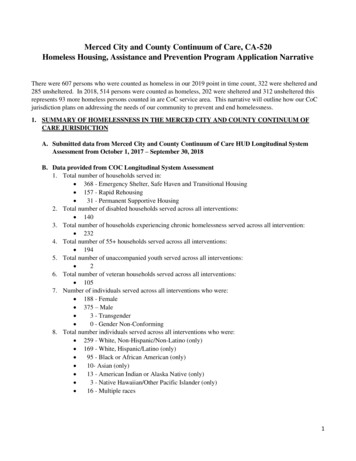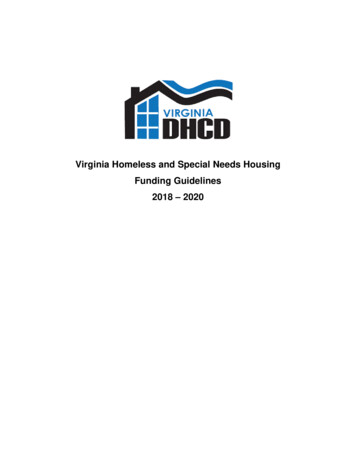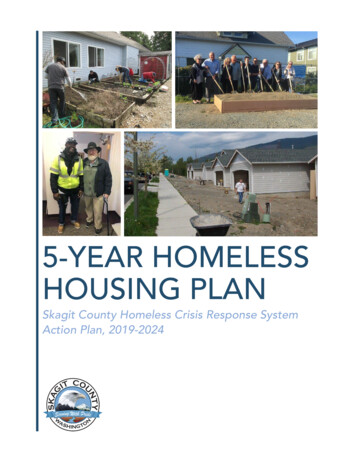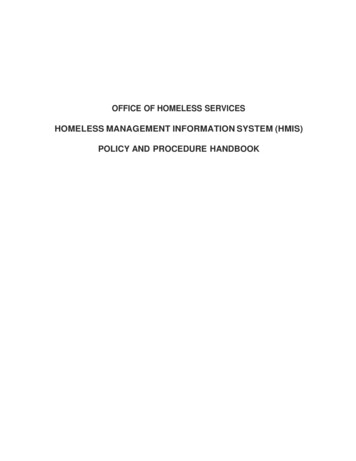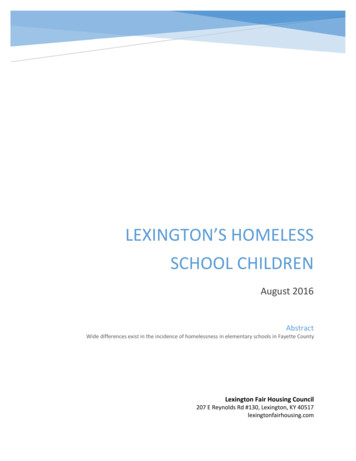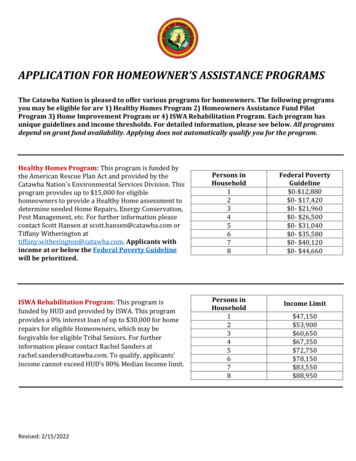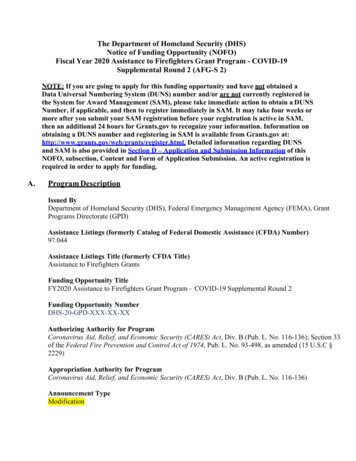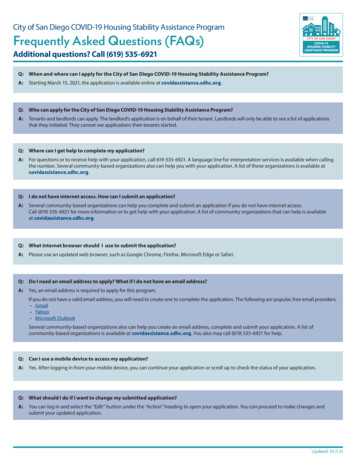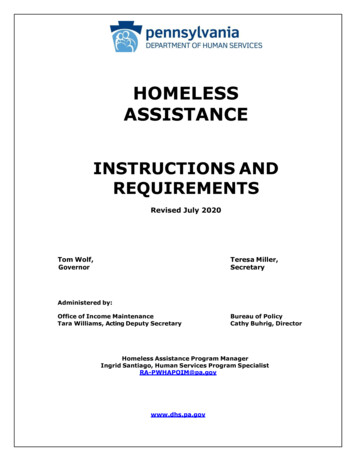
Transcription
HOMELESSASSISTANCEINSTRUCTIONS ANDREQUIREMENTSRevised July 2020Tom Wolf,GovernorTeresa Miller,SecretaryAdministered by:Office of Income MaintenanceTara Williams, Acting Deputy SecretaryBureau of PolicyCathy Buhrig, DirectorHomeless Assistance Program ManagerIngrid Santiago, Human Services Program SpecialistRA-PWHAPOIM@pa.govwww.dhs.pa.gov
TABLE OF CONTENTSChanges from previous version . 4I.OVERVIEW . 5A. Introduction . 5B. The Homeless Assistance Program Goals. 6C. Continuum of Homelessness Services . 7II.HAP SERVICE COMPONENT DESCRIPTIONS . 7A. Case Management . 7B. Rental Assistance .11C. Bridge Housing . 17D. Innovative Supportive Housing Services . 22E. Emergency Shelter . 23III.HAP REQUIREMENTS . 25A. Client Eligibility.26B. County and Provider Responsibilities . 28C. Client Records . 30D. Written Agreements . 31IV.ALLOWABLE HAP EXPENDITURES – GENERAL . 32V.FISCAL RESPONSIBILITIES . 34A. Cost Allocation Plan . 34B. Grant Revocation . 35C. Payments . 35D. Automated Clearing House Process . 35E. Holding Funds . 35F. Unexpended Funds .35G. Earned Interest . 362
H. Accrual Accounting . 36I. Audits . 36J. Maintaining Fiscal Records . 36K. County Human Service Planning and Expenditure Reports . 37L. Annual Client Data Report .37M. Revisions to County Plans . 38VI.RESOURCES AND INCOME . 38A. Income .39B. Resources . 42C. Affordability . 43VII.CLIENT APPEALS . 44VIII. WAIVER REQUESTS . 45IX.PROGRAM MONITORING . 46APPENDICESA. EVALUATING PROGRAM PROCESSES AND OUTCOMESFOR CONTINUOUS QUALITY IMPROVEMENT . 50B. SERVICE PLANS . 53C. FEDERAL POVERTY INCOME GUIDELINES. 55D. RENTAL ASSISTANCE TRACKING FORM. 57E. COORDINATION WITH TITLE IV-A EMERGENCY SHELTERASSISTANCE PROGRAM .58F. KEY DATES . 60G. CLIENT RECORDS . 61H. ANNUAL CLIENT DATA REPORT. 63I. INCOME, RESOURCES AND AFFORDABILITYCALCULATION WORKSHEETS . 69J. HAP Block Grant Counties. 743
April 2020CHANGES TO HAP I&R FROM THE PREVIOUS VERSION OF MAY 2018Page 1 – revised date updated.Page 12 – Waiver requests for Rental Assistance during a disasterPage 55 – Federal Poverty Income Guidelines changed to reflect new 2020 amounts.Page 67 – Fiscal Year 2020-2021 Client Data Report added.July 2020Page 41 – Additional Income not used updatedPage 74 - New Block Grant counties added4
I. OVERVIEWA. INTRODUCTIONThe Homeless Assistance Program Instructions and Requirements(HAP I & R) manual provides operational guidance for the Pennsylvania Department ofHuman Services’ (DHS) Homeless Assistance Program (HAP).HAP is a county-directed program that offers a variety of supportive services toindividuals and families experiencing or at risk for homelessness and who candemonstrate that, with HAP intervention, they will be able to meet their basic housingneeds in the near future.HAP includes five components:1.Bridge Housing2.Case Management3.Rental Assistance4.Emergency Shelter5.Innovative Supportive HousingA county may choose to provide one, some, or all of the components as part of itsprogram, depending upon its unique regional needs. HAP gives counties flexibility increating their programs because human service agencies based at the local level areintimately acquainted with the local human services network and the needs of thecommunity. The department expects that counties will select the components necessaryto create a homeless assistance program that meets the following HAP objectives:1.Provide homelessness prevention services that assist clients to maintain affordablehousing.2.Help people experiencing homelessness find refuge and care.3.Assist people experiencing or near homelessness in attaining economic selfsufficiency.5
The Commonwealth of Pennsylvania funds HAP through an annually state-fundedblock grant. The DHS Office of Income Maintenance (OIM) administers HAP and allocatesa portion of the block grant funds to each county with the expectation that counties willdesign homeless assistance programs that meet HAP goals within the parametersoutlined in the HAP I & R.Before 2001, all counties received HAP funds as a program-specific allocation. In2012, Act 80 introduced county-based Human Services Block Grants (HSBG) in 20Pennsylvania counties. The HSBG combined the funds of seven human servicesprograms, including HAP, into one block grant. The HSBG reduced overall funding for thecombined human services agencies; however, it gave counties the latitude to reallocatefunds among the seven human services programs.While the initial pilot included only 20 counties, in July 2013, Act 55 expanded theavailability of HSBG funding to 30 counties. Act 153, enacted November 4, 2016,expanded the option for all counties to apply for participation in the HSBG programbeginning July 1st, 2017. The Act also provides direction for counties that wish towithdraw from the HSBG program.The introduction of the HSBG presents HAP with exciting challenges. In eachsubsequent year following the implementation of the HSBG, HSBG counties canreallocate increasing percentages of the HSBG funds among the seven human servicesprograms. While residents’ needs will influence how counties allocate the HSBG funds,programs that demonstrate success through measurable outcomes will have greatercredibility when justifying continued or increased funding.The department provides the HAP I & R as guidance for developing effective, locallyintegrated Homeless Assistance Programs. The HAP I & R addresses HAP changesintroduced with the HSBG and includes the HAP programs goals, descriptions of the fiveHAP components, criteria for client eligibility, allowable HAP expenditures, fiscalreporting requirements, and expectations for program monitoring. It also providesstrategies for counties to identify program goals, measure outcomes, and use findings torefine and improve their programs (see Appendix A).B. THE HOMELESS ASSISTANCE PROGRAM GOALSCounties receiving HAP funding will develop programs that achieve the followinggoals: Mitigate the effects of homelessness on families and individuals through preventionactivities, case management services, and housing and rental assistance.6
Help families and individuals experiencing homelessness become self-sufficient andsecure permanent living arrangements. Provide homelessness prevention activities, which allow the people who are nearhomeless to retain affordable housing or move to more affordable housing. Develop a continuum of services to support individuals and families who areexperiencing or are at risk for homelessness. Comply with programmatic requirements (e.g. verifying and calculating income,maintaining case notes, etc.), reporting requirements, and monitoring requirementsas outlined in the HAP I & R.C.CONTINUUM OF HOMELESSNESS SERVICESWhile HAP addresses housing issues specifically, in order to mitigate homelessnessand help families achieve self-sufficiency, counties should view HAP as part of a largerholistic approach to human services requiring coordination between a variety of agenciesand community services. Counties should coordinate HAP planning with other agencies,enabling providers to link clients to other services necessary to achieve self-sufficiency.The community planning process should include staff from homeless serviceproviders, state and local governments, human service providers, private foundations,local businesses and investors, the financial community, neighborhood groups, landlordsand housing providers, and individuals and families who are or who have experiencedhomelessness.Planning and coordinating with other county service programs will help HAPproviders identify service needs, avoid duplicating services, and prevent disjointedservice delivery. Counties can then leverage HAP funds to provide the mostcomprehensive, innovative, and cost-effective services to their residents who arehomeless or at risk for homelessness.II. HAP SERVICE COMPONENT DESCRIPTIONSA. CASE MANAGEMENTCounties use the case management component to coordinate the activitiesnecessary for the client to obtain or retain housing and to achieve self-sufficiency.Effective case managers provide a blend of assessment and coordination services. Theypossess in-depth knowledge of communities and available services and housing, mixedwith genuine empathy and respect for the families and individuals seeking theirassistance. Case management is defined as a “collaborative process that assesses,7
plans, implements, coordinates, monitors, and evaluates the options and servicesrequired to meet the client’s health and human service needs. It is characterized byadvocacy, communication, and resource management and promotes quality and costeffective interventions and outcomes1.”Case Management begins with the intake process and assessing the client’savailable resources and supports and what services the client needs. Followingassessment, the case manager and the client should collaborate to develop a serviceplan that includes setting goals in the areas of basic life skills, health needs, financialmanagement, parenting skills, home maintenance, job preparation skills, and/oremployment skills and helping clients access the agencies and programs that can helpthem achieve their goals. Once the family or individual is stable, the case managershould review ongoing risk factors and provide coaching. Finally, the case managershould link the family or individuals to ongoing supports, if needed, to help themmaintain long-term stability and monitor their progress to ensure the client has access toneeded and desired services.Case Management service activities include but are not limited to the following:1.Intake and assessments for individuals who are in need of supportive services andwho need assistance in accessing the service system.2.Assessing service needs and eligibility and discussing available and acceptableservice options with the client.3.Preparation of a service plan based on an assessment with specific, attainable,measurable objectives developed in cooperation with and signed by the client (seeAppendix B).4.Referring clients to appropriate agencies for needed services.5.Coordinating services of clients who are receiving multiple services.6.Providing direct services such as counseling, where appropriate, budgeting, lifeskills, job preparation, tenant/landlord rights and responsibilities, and homemanagement.7.Providing advocacy, when needed, to ensure the satisfactory delivery of requestedservices.1 Commission for Case Manager Certification (CCMC). Definition and Philosophy of Case se-management8
8.Monitoring the continuity and appropriateness of services through an ongoingreassessment process, during which case manager and client revisit the prioritiesidentified in the initial assessment and discuss the client’s emerging concerns.9.Follow-up to evaluate the effectiveness of services and outcomes.10. Protecting the client's confidentiality.Counties must make case management available to any client receiving HAPservices. Case management is an important part of meeting the HAP goal of preventinghomelessness because it allows the case manager to identify needs and put services inplace before a family loses housing.A major role of the case manager is advocating for families or individualsexperiencing or at risk for homelessness in the search for permanent housing and innavigating the social service and educational systems. Case managers should makespecial efforts on behalf of homeless children by collaborating with school districts, eachof which has a coordinator for homeless children who will assist in making educationalarrangements during periods of transition. Case managers should develop workingrelationships with other community service providers, such as housing authorities andother local housing programs; the CareerLink; the County Assistance Office; local foodbanks; local charitable organizations; and any agencies that can support the family inachieving self-sufficiency. By working with a local network of human service agencies,the case manager can also become aware, as confidentiality allows, of the service planswithin other agencies and establish goals that do not conflict.GUIDELINES – Case ManagementThe following guidelines apply to case management services: Counties may set maximum income limits (up to 200% of the Federal Poverty IncomeGuidelines, see Appendix C) for the at-risk clients served in the component. The county may develop local policy regarding qualifying for case managementservices. Counties may require clients to receive case management in order to receive otherHAP services. For example, clients who repeatedly request financial assistance maybe required to participate in case management services in order to qualify for otherprogram components.9
Counties will fund all case management functions required in HAP componentsthrough the Case Management component. Counties must develop a policy requiring the client’s active participation in casemanagement services in order to receive HAP-funded rental assistance or HAPfunded Bridge housing services.EXPENDITURES - Case ManagementDHS expects that counties will spend the majority of this HAP allocation onpersonnel expenses (wages, salaries, and benefits) for case managers so they mayprovide necessary and appropriate case management services such as: Intake and assessment. Preparation of written service plans. Arranging for needed medical, psychological, psychiatric, social, educational, orvocational services. Follow-up and client tracking. The cost for providing direct services such as counseling, budgeting, life skills, jobpreparation, and home management as described.(A)Allowable Expenditures Operating: office rent, communications, insurance, legal services, audits,office supplies, staff travel, overhead, and systems consultants and clienttracking. Fixed Assets: equipment. Personnel: wages and salaries, benefits, and training/conferences.(B)Non-Allowable Expenditures Payments made on behalf of clients for shelter or support services otherthan Case Management. Payments for already existing Case Management services.10
Food purchases for business meetings, client classes, training, and clientrecognition events.B. RENTAL ASSISTANCERental Assistance includes assistance to prevent homelessness or nearhomelessness by intervening in cases where an eviction is imminent. This may includehousing payments paid on behalf of the client for:1.Rent.2.Mortgage arrearage for home and trailer owners.3.Rental costs for trailers and trailer lots.4.Security deposits.5.Utilities to prevent and/or end homelessness or near homelessness by maintainingindividuals and families in their own residences.6.Expediting the movement of people out of shelters into existing housingService providers, in conjunction with the county, should maintain flexibility whendeveloping criteria for disbursing funds for rent, utilities, and security deposits. Forexample, an agency may choose to provide only rental assistance or to establish amaximum amount of funds available for utility assistance.The department strongly recommends that only one service provider in a countyreceive HAP funds to provide rental assistance services in each county. In countieswhere other agencies with different funding sources provide services similar to rentalassistance, the county must develop a system like a clearinghouse to eliminate duplicateservices and payments to a household. It is important that counties seriously considerusing only one rental assistance provider because, even in counties with clearinghouses,clients sometimes make back-to-back requests from different agencies, unbeknownst tothe other agency, thereby receiving assistance that exceeds the limit.Where appropriate, service providers should encourage clients receiving rentalassistance to participate in budgeting and money management training in an effort toprevent future rental crises for the client. Case Management should guide the client tobecome self-sufficient and be available to clients for as long as necessary. Counties thatdo not provide case management should refer clients to existing case management11
services such as the Office of Children, Youth and Families or the Office of Mental Healthand Intellectual Disabilities, etc. HAP funds can purchase budgeting and moneymanagement programs from other agencies, if necessary.The county may pay rental assistance funds for mortgage arrearage, rental costs, orutility assistance to owners of homes or mobile homes on behalf of the client. It is thepayment of last resort and written documentation must support the need.Individuals or families living in subsidized housing and Section 8 housing are eligibleto request assistance with their security deposit and first month’s rent. However, forthis population, the county may also choose to pay for rental arrearages.Counties may consider hotels, motels, and boarding homes as long-term housingand the county may or may not choose to assist clients with rental assistance paymentsin these situations. Clients requesting this type of assistance must provide writtendocumentation of long-term living arrangements. This documentation may include areceipt for a security deposit, a signed lease agreement, or other documentation thatverifies that this unit will be or has been a long-term living arrangement.The department does not intend for the rental assistance component to substituteas an energy assistance program. Utility assistance is available to the extent that itmeets the objective of preventing homelessness for people who are able to afford theirhousing after receiving assistance.In some cases, rental assistance clients may become scattered-site bridge housingclients. For example, if the client requests rental assistance and the provider determinesthat the rental payment to prevent eviction will only prolong the inevitable eviction,short-term rental subsidy, and supportive services is a more appropriate service to helpthe client become self-sufficient. The county can provide rental assistance to prevent theimmediate threat of homelessness, followed by scattered-site bridge housing so theclient can receive the services necessary to become self-sufficient (see Bridge Housingrequirements for detail on serving clients under the scattered-site model).NOTE: During a State of Emergency, Natural Disaster, Moratorium on no evictions,a localized area affected by a disaster, or a Public Health emergency to preventevictions in cases where an eviction would be imminent, a waiver can be requested tonot require an eviction notice.The person must provide verification that they did not have the ability to pay theirrent and to avoid future eviction, a rental assistance check would benefit the householdto prevent homelessness during the time of the disaster.12
Reminder: HAP is the payor of last resort and written documentation mustsupport the needWhen Rental Assistance funds are used for a security deposit for rent or utilitiesand, the client later moves elsewhere, the program may choose whether to recoup thesecurity deposit or not. The service provider may allow the client to use the deposit assecurity for a new apartment. If a client or landlord returns the security deposit to thecounty or service provider, they can spend the returned security deposit in the year itwas returned regardless of what year the deposit was originally paid. The county mustshow the returned deposit on the Final Expenditure Report as PROGRAM INCOME andexpend it in any one of the HAP service components.NOTE: Appendix D provides an example of an administrative tool that counties can usefor tracking rental assistance issuances.GUIDELINES – Rental AssistanceCounties offering the rental assistance component are required to make every effortto ensure that the following procedures are in place: Permit the client to apply for rental assistance on the same day the applicant visitsthe office. Interview the applicant on the same day the applicant applies for rental assistanceand, and if all required verification is presented, determine eligibility at theapplication interview. Applications for assistance must be processed so that theclient is served in time to resolve the crisis and prevent the eviction. If all the verification is not presented at the interview, provide the client with apending verification list and a due date for the pending items. Provide the client with a written notice approving or denying their request forassistance. Provide the client with written information on their right to appeal adverse actionsand the process to do so (see Section VII for more details on the appeal process). Provide the client with written information on their appeal rights to the county andthe DHS Office of Hearing and Appeals. Utilize collateral contacts to verify homelessness, near homeless, the amountneeded to resolve the crisis, and the landlord’s agreement to rent to the client in thefuture or to stop eviction proceedings, and hand-written or questionable documents.13
Emphasize the prevention of homelessness for families with children. Counties may choose, but are not obligated, to use funds to move clients from onecounty to another county. If a county chooses to provide funding to move a client toanother county, the county should contact the receiving county HAP to inform themof the services provided and the payment amount in order to avoid duplication ofservices. Counties and providers must maintain a relationship with the County AssistanceOffice (CAO) to ensure that there is coordination of services (see Appendix E formore detail on the required coordination).EligibilityTo qualify for rental assistance, clients must be homeless or near homeless AND: Have an agreement with the landlord to rent to them; AND Have sustainable income sufficient to pay rent in the future or have no income buthave reasonable expectations for sufficient income in the next 90 days to maintainrental agreements; AND Have an income at or below 200 percent of the federal poverty income guidelines(FPIGs).Counties and service providers must establish poverty guidelines for determiningeligibility. The maximum level for income eligibility must be between 100 percent and200 percent of FPIGs. If a county chooses to set the maximum at 100 percent, thenthey will serve clients who are at or below 100 percent of FPIGs. If the county serves aclient with no income, the client file must reflect the reason the case manager made thedecision to assist the client. This requirement ensures that HAP funds are not availableto clients who will not have sufficient income within a 90-day period.Counties and service providers must count the total gross income and resourcesof each adult person (18 years of age or older and not in high school full-time) whendetermining eligibility for services under rental assistance. Any government assistance(federal, state, or local), including FEMA dollars, provided to clients for rental assistance,mortgage assistance, security deposit, and/or utility assistance (except for LIHEAP)during any 24-consecutive month period must be included when calculating themaximum amount of assistance the client may receive - 1,000 (adult-only households)or 1,500 (households with children).14
Counties and service providers do not count assistance received from Low IncomeHome Energy Assistance Program (LIHEAP) grants in the calculation of the 1,000 or 1,500 maximum available to the client. Counties may make utility payments to clientswho are eligible for LIHEAP if LIHEAP funds are not available. Exclude diversion benefitsthat families receive from the CAO when determining eligibility or the amount of HAPassistance. (See Section VI. Income and Resources for a full discussion of income andresources counted and excluded when determining eligibility for services).Counties must retain copies of the income and resource verification, the calculationsused to calculate eligibility, and amount of assistance granted in the client record (formore information about client records, see Section III, C).NOTE: People seeking rental assistance who are escaping domestic violence donot have to meet income guidelines. If they have received rental assistance inthe past, the county may disregard the maximum limits. The county will acceptthe following verification that the client is experiencing domestic violence: Any type of documentation including law enforcement records, courtrecords, medical/treatment records, social service records, child protectiveservice records. Third party verification from:ooooo A domestic violence service provider;A medical, psychological, or social service provider;A law enforcement professional;A legal representative; orAn acquaintance, friend, relative, or neighbor of the claimant, or otherindividual.If the individual is unable to safely obtain any of the items above, the clientmay self-affirm domestic violence, and the county will determine if theclients’ request is reasonable. Do not require the individual to obtain aprotection from abuse order as verification of domestic violence.Providers must maintain client privacy and safeguard all domestic violenceinformation to the fullest extent possible. Providers must assure individualsthat the personal data that they provide will be confidential. This is of criticalimportance to domestic violence victims since their physical well-being or lifemay be endangered should the abuser learn their whereabouts. Protecting thevictim’s address as well as other pertinent data is vital to family safety.15
If a countywide disaster occurs, those affected should seek assistance from the RedCross. If the client requires additional assistance, that may be provided by HAP. Countiesshould not use HAP funds to duplicate available services but can be used in addition toother services when necessary. In the event of countywide disaster, the county mustcontact the HAP Program Manager for permission prior to disbursing any HAP funds.HAP funding should be the resource of last resort.Benefit Amount, Frequency, and Mode of IssuanceDuring a consecutive 24-month period, clients may receive up to a maximum of 1,000 for adult-only households or 1,500 for families or households with children. A“household” is defined as one or more persons, related or unrelated, who reside orintend to reside in a common residence. The 24-month period begins with the issuancedate of the first check. When determining client eligibility, providers should ask if theclient has resided in another county within the past 24 months and, if so, contact thecounty HAP to inquire if the client received services and the payment amount, in order toavoid duplication of services. Counties should respect client confidentiality and seekpermission for release of information from the client. Counties must maintain thereleases in the client record (see Section III, C and Appendix G related to client records).If a household requesting assistance includes an adult member who, within the past24 months, received a rental assistance payment as a member of another household,the provider may issue a payment to the household. However, the provider mustcalcula
6 The Commonwealth of Pennsylvania funds HAP through an annually state-funded block grant. The DHS Office of Income Maintenance (OIM) administers HAP and allocates
